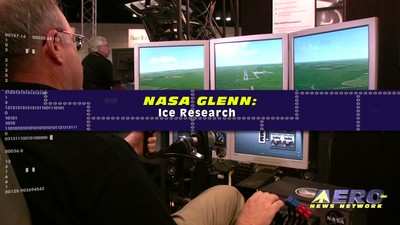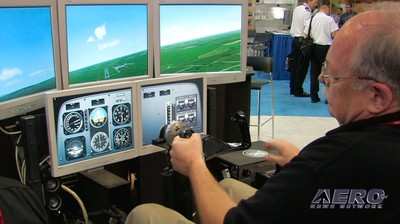Thu, Oct 09, 2008
Late last year, ANN's Aero-TV crews spied a truly marvelous
piece of flight simulation technology... NASA Glenn's icing flight
training simulator. Demonstrated at the Interservice/Industry
Training, Simulation and Education Conference (I/ITSEC), we were
incredibly impressed at the apparent accuracy of the model (ANN's
Jim Campbell has plenty of Twin Otter time -- the aircraft used in
the icing encounter sim model -- and knows only too well that the
icing behavior they displayed is what he has experienced,
personally, in real icing conditions).

The high-fidelity simulation model for icing effects flight
training was developed from wind tunnel data for the DeHavilland
DHC-6 Twin Otter aircraft. First, a flight model of the un-iced
airplane was developed and then modifications were generated to
model the icing conditions.
The models were validated against data records from the NASA
Twin Otter Icing Research flight test program with only minimal
refinements being required. The goals of this program were to
demonstrate the effectiveness of such a simulator for training
pilots to recognize and recover from icing situations and to
establish a process for modeling icing effects to be used for
future training devices.

NASA notes that 'Developing flight simulators that incorporate
the aerodynamic effects of icing will provide a critical element in
pilot training programs by giving pilots a pre-exposure of
icing-related hazards, such as ice-contaminated roll upset or
tailplane stall. Integrating these effects into training flight
simulators will provide an accurate representation of scenarios to
develop pilot skills in unusual attitudes and loss-of-control
events that may result from airframe icing.'
ANN first saw this technology demonstrated at I/ITSEC, an
organization that promotes cooperation among the Armed Services,
Industry, Academia and various Government agencies in pursuit of
improved training and education programs, identification of common
training issues and development of multiservice programs. The 2008
rendition of this event comes this December 1-4, 2008.

More News
Light Gun A handheld directional light signaling device which emits a brilliant narrow beam of white, green, or red light as selected by the tower controller. The color and type of>[...]
"The journey to this achievement started nearly a decade ago when a freshly commissioned Gentry, driven by a fascination with new technologies and a desire to contribute significan>[...]
Aero Linx: JAARS, Inc. For decades now, we’ve landed planes on narrow rivers and towering mountains. We’ve outfitted boats and vehicles to reach villages that rarely se>[...]
"Our driven and innovative team of military and civilian Airmen delivers combat power daily, ensuring our nation is ready today and tomorrow." Source: General Duke Richardson, AFMC>[...]
Aircraft Conflict Predicted conflict, within EDST of two aircraft, or between aircraft and airspace. A Red alert is used for conflicts when the predicted minimum separation is 5 na>[...]
 ANN's Daily Aero-Term (04.20.24): Light Gun
ANN's Daily Aero-Term (04.20.24): Light Gun Aero-News: Quote of the Day (04.20.24)
Aero-News: Quote of the Day (04.20.24) ANN's Daily Aero-Linx (04.21.24)
ANN's Daily Aero-Linx (04.21.24) Aero-News: Quote of the Day (04.21.24)
Aero-News: Quote of the Day (04.21.24) ANN's Daily Aero-Term (04.21.24): Aircraft Conflict
ANN's Daily Aero-Term (04.21.24): Aircraft Conflict





